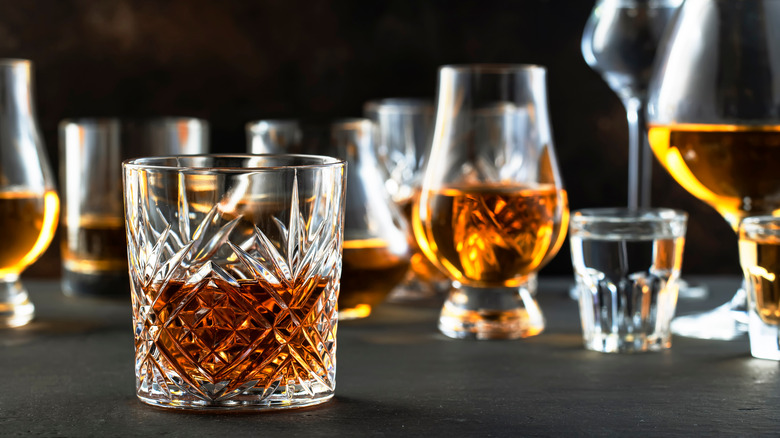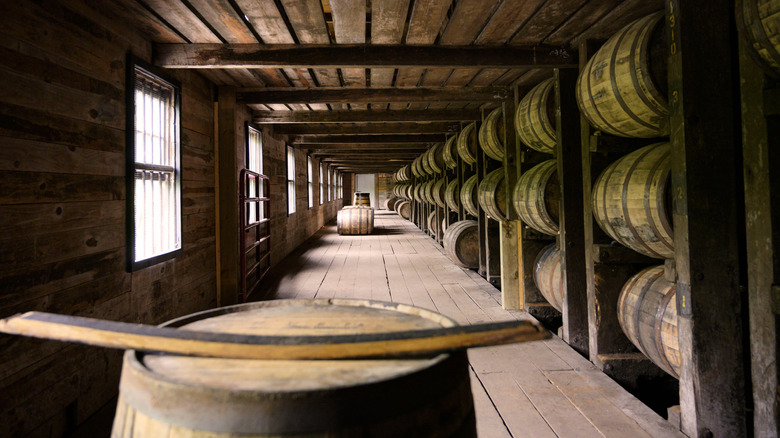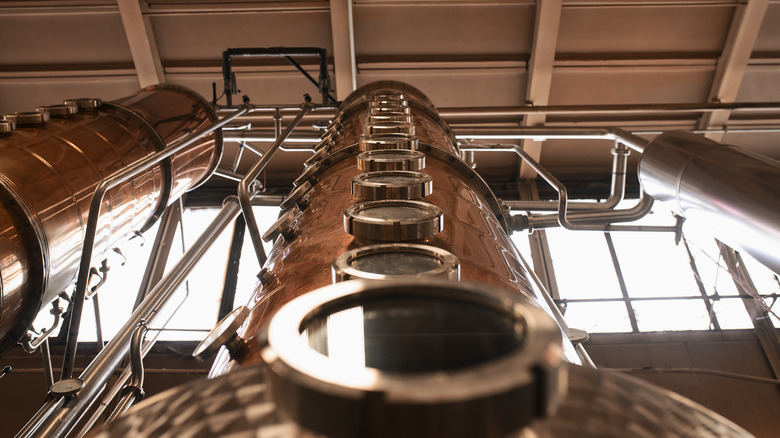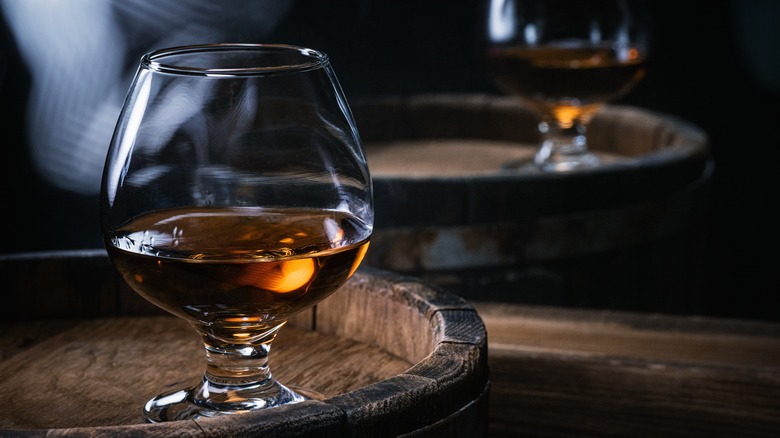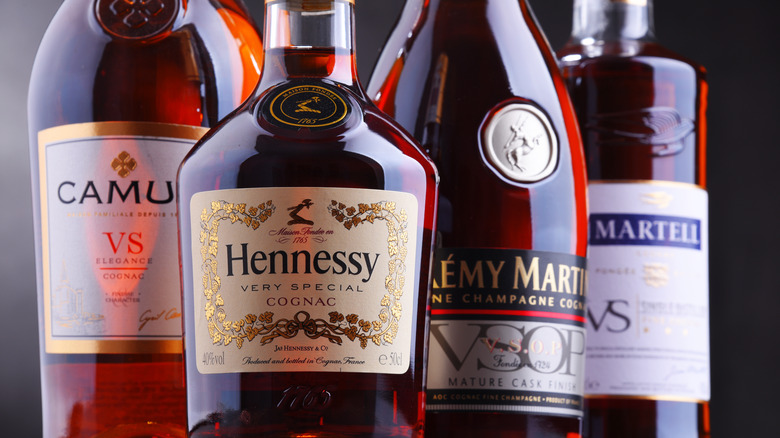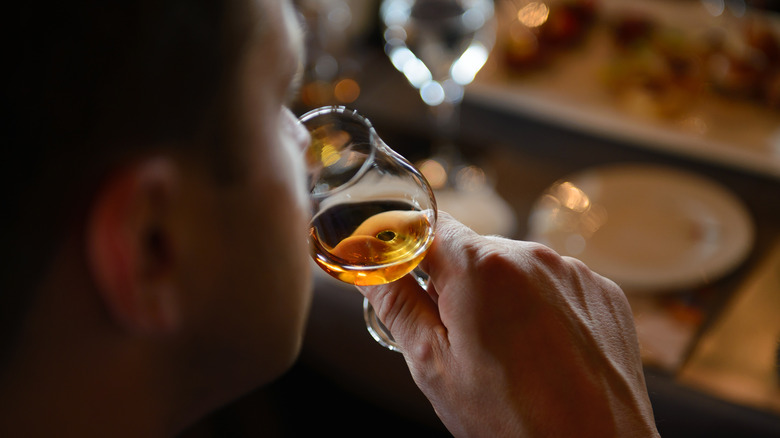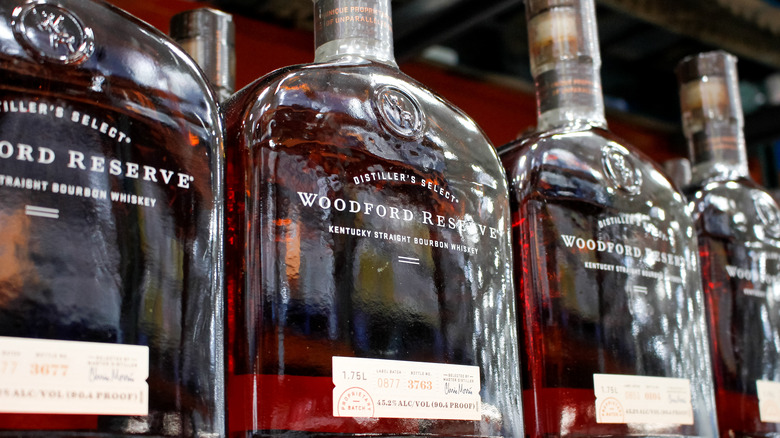What's The Difference Between Cognac And Bourbon?
Dark, easy-sipping liquors are one of the finest delights of drinking, and they are more accessible to you than you may think. Filling a glass with a rich, smooth spirit to mark a special occasion, help ease digestion after a meal, or just relax at the end of the day is as simple as simple pleasures come. Everyone deserves to indulge in such a libation now and again. For those without a well-established taste in liquor preferences, there may not be a better way to do it than with a quality bourbon or cognac.
These two liquors may look alike, serve similar purposes, and evoke the same emotions from whoever enjoys them, but they are vastly different distilled spirits that should not be grouped together. In fact, bourbon holds its own category of whiskey, and cognac isn't even a whiskey but a style of brandy instead. Plus, the two vary in origin, taste, and price point, so here's everything you need to know to start enjoying both bourbon and cognac to their maximum potential.
History
The most fundamental difference between bourbon and cognac is where they're produced. Not only do these two spirits come from different continents, but they are also prideful exports specific to their home countries.
Bourbon is the quintessential American spirit. As immigrants from Scotland and Ireland began settling in the Midwest during the 19th century, they brought with them the distilling techniques of their homeland (via The Manuel). Corn was an abundant, reliable crop of the region, so it only made sense to utilize it for making booze. The craft quickly became widespread, making the state of Kentucky the bourbon capital of the world. The spirit sustained through the Prohibition era. It continues to be a powerhouse of the drink world and is an iconic piece of American culture and history.
Cognac, on the other hand, is a rather old spirit whose origin long predates bourbon. In the 16th century, the Dutch began traveling to France but grew concerned their wine would not last the journey back, per The Whisky Exchange Cognac Show. So, they decided to distill the wine to extend its lifespan. The brandewijn (or "burnt wine") that resulted came to be known as brandy. Although the Dutch are responsible for the invention of the spirit, the distinction known as cognac is unmistakably French. Just like how Champagne gets its name from the Champagne region, cognac is named after the country's Cognac region. Only brandy made in Cognac can hold this regional designation. Otherwise, it's just brandy.
Production
The main ingredient in distilling bourbon whiskey is corn, but there are other requirements regarding the mash bill, aging, additives, and alcohol content to qualify whiskey as bourbon (via MasterClass). These stipulations are actually a matter of legality, dating back to the early to mid-20th century, according to Angel's Envy. The mash bill, or combination of grain, must contain at least 51% corn, be aged in newly charred white oak barrels, have an alcohol by volume (ABV) of at least 40%, and be produced entirely in the United States.
Like all whiskey, the required mash bill is combined with water and yeast and heated before fermentation. After one to two weeks of fermenting, the solution is strained and then purified through distillation. The distillate is then aged for at least two years. Depending on the manufacturer, the bourbon is then diluted to ensure a specific ABV before it's bottled and distributed to be purchased and enjoyed.
All cognac starts with wine, but the distillation, aging, and blending require particular specifications, according to Distillery Du Peyrat. Distillation is essentially an extraction of the wine's alcohol content, and cognacs are double-distilled, ensuring a complete extraction that leaves behind nothing but wine residue. This high-proof alcohol is then aged in French oak casks, also for a minimum of two years. The final product is dependent on the master blender, who decides to either keep the cognac as a single-barrel spirit or blend it with cognacs of various ages.
Taste
If drinking whiskey is something you haven't gotten into yet, bourbon is a great access point to the spirit. Due to its high percentage of corn, bourbon is a sweeter whiskey that is more palatable to whiskey novices than other options like scotch or rye. In addition to a general sweetness, bourbon's aging in charred oak makes contributions beyond its deep color. Barrel notes of oak, vanilla, and caramel are signature flavor and aroma characteristics of bourbon that make it not just a spirit to be used in cocktails but one that can be sipped neat or on the rocks, as long as it's well-made. Bourbons are quite limited in taste and flavor, and the longer a bourbon ages, the smoother it becomes. However, if it spends too much time in the barrel, the deep flavor can be lost, and it may take on "bitter or ashy" notes (per Eight Oaks Farm Distillery).
If you prefer sweetness in liquor, cognac will fulfill your taste. Because of the similar maturation, cognac also carries those woody notes of oak and vanilla, but it presents fruitier aromas and flavors of orange, apricot, and dark fruit as well (via Cognac Expert). Cognac is definitely a brighter spirit than bourbon, with easier palatability and a silkier mouthfeel. An extensively aged cognac refines these notes further and even develops new ones over time. Like wine, the more you venture into the world of cognac, the more flavor nuances you will find.
Brands
In the world of bourbon, many historic brands own a piece of American history. You'll also find newer ones that have only just started their contribution to the industry. The most popular bourbon brands include Elijah Craig, Maker's Mark, and Wild Turkey. These are all classic bourbons that are straightforward, accessible, and well-established. Other notable brands are Basil Hayden, Buffalo Trace, Bulleit, Four Roses, and Woodford Reserve. There are, of course, many other iconic brands of bourbon that come in at a wide variety of price points. For those who have yet to delve into bourbon, these are some of the ones worth trying first.
As for cognac, the powerhouse of the industry is Hennesy, bar none. Hennessy is the highest-selling cognac brand in the United States and one of the most popular in the world (via Drinks International). Other well-known, well-made cognacs include Courvoisier, Martell, and Rémy Martin. In America, the popularity of cognac is definitely not as widespread as bourbon, so finding a specific brand in a liquor store may not be as doable as bourbon, which you can easily find upwards of a dozen brands on the shelves. These brands, however, will surely be available for purchase at most stores and are a great starting point for cognac newcomers.
Uses
When sipping on bourbon or cognac neat, glassware plays an important role. Ideally, a Glencairn glass is best for tasting bourbon. These thin, tulip-shaped glasses allow plenty of space for the nose to enter and appreciate all the aromas the whiskey has to offer (via Insider). Cognac and the broader brandy category claim their own glassware style, per Advanced Mixology. Brandy glasses, or snifters, look like miniature versions of a Belgian beer glass, with a wide, round body atop the short, lean stem. These also allow the cognac to breathe inside the glass and enhance the aromatic pleasure.
Both of these spirits certainly do not require any accompaniments other than a clean glass and beloved company, but bourbon and cognac contribute to many traditional, modern, and delicious cocktails. Classic bourbon drinks like the Old-Fashioned, bourbon smash, and Boulevardier are obvious icons. Modern classics, such as the bourbon renewal, Kentucky maid, and paper plane, can also elevate the spirit to new and exciting heights. Cognac is found in cocktails like the sidecar, brandy Alexander, Wisconsin Old-Fashioned, and Vieux Carre (via Difford's Guide), all of which simultaneously highlight the depth of flavor in cognac and complement it.
Of course, there are no rules about how to enjoy these spirits. No matter how you choose to use your bourbon or cognac, keeping things simple and focusing on the spirit is always encouraged. More than anything, do what makes you feel good.
Price
Bourbon and cognac are both delicious spirits that are well deserving of a spot in your home bar. As far as price goes, bourbon is definitely the more economical liquor. There are a wide variety of simple, high-quality bourbons for less than $50 on the market, and several are even below $30. Now, there are ultra-rare bottles with prices that can get up to the tens of thousands, but these are more collector's items than drinking bourbons. You do not need to break the bank for a quality, easy-sipping bottle of bourbon, though you may have to pay a little more for a good bottle of cognac.
The higher costs of cognac are due, in part, to the grapes. They're an expensive base product to distill, whereas the grains used for bourbon-making are not. Also, cognac production yields a far lower volume, so because there is less to be sold, prices must be higher (via Eater).
Additionally, cognac is broken up into subcategories, each of which correlates to different price points. For example, V.S. ("very special") is a cognac aged for the two-year minimum, V.S.O.P. ("very special old pale") is aged for at least four years, and X.O. ("extra old") cognacs are aged at least six years. The latter is often attributed to special or premium editions. To put things into perspective, the standard bottle of Hennesy is a V.S. cognac and tends to cost $20 less than the brand's V.S.O.P. expression (via Drink Spirits).
